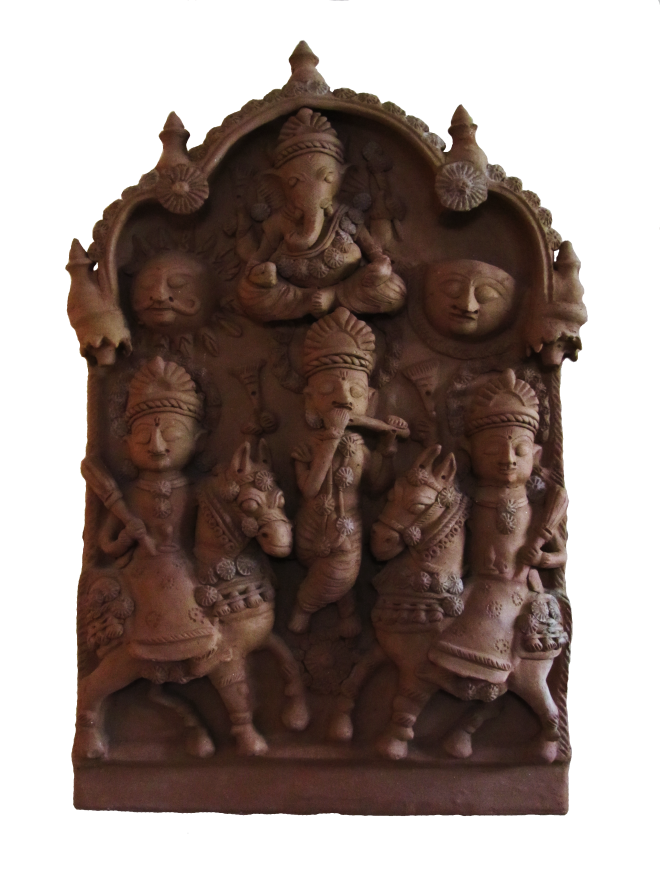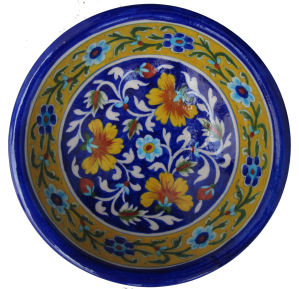
Molela village lies near the temple town of Nathdwara in the Rajsamand district of Rajasthan. It is also easily accessible from the lake city of Udaipur. The potters or kumhars of this village are renowned far and wide for their terracotta products, especially the ritual plaques.
These plaques depicting local gods and goddesses are made for their traditional clientele, who belong to the tribal groups of Bhil, Gujari and Garijat. Many of them travel hundreds of kilometres which can even stretch to far off places in Madhya Pradesh and Gujarat, to buy these plaques from the potters of Molela. It is customary to replace these plaques depicting idols from time to time and hence, they arrive at Molela accompanied by their priests, Bhopas, to select the appropriate icon. The potter is paid with respect in cash, grain, a coconut and 1.25 metres of cotton cloth (red for female deity and white for male deity). This is followed by a procession to the nearby Banas river where the deity is worshipped after which it makes the final journey to be installed in homes or village shrines amidst prayers and festivities.[1]
Clay is procured from the Banas river bed which flows in close vicinity to the village and is prepared with added donkey dung and husks to make it easier for moulding. The plaques are hand moulded except for the embellishments of the domed chhajja which are wheeled turned. All the figures are created entirely by fingers and kept hollow to avoid breakage during the firing process. At completion, they are left to dry on the sun for hardening. After which they are stacked and set afire on a temporary kiln. These plaques are traditionally painted with natural colours with a final coat of lacquer or left plain.
Incarnations of Hindu gods and goddesses as well as local heroes are delightfully represented in these plaques. One of the prominent images is of two deities referred to as Kala-Gora, who are the two forms of Shiva. Kala painted in dark blue, being Bhairava (the terrific manifestation) and Gora in orange, is Virabhadra. Kala is generally appeased with the offering of liquor and animal sacrifice while Gora being calm, offered sweet meats.[2] Another local deity Dev Narayan also called Dharamraj is represented frequently as an equestrian figure holding a spear. Dev Narayan is also attributed with the tale of origin of Molela terracotta, appearing in the dream of a blind potter instructing him to create his image in clay with the promise of a secured livelihood, which was later continued by his descendants. Other deities such as Pabuji, Sandmata (mother goddess who rides a camel), Singhmata (form of Durga), Bhunaji and Mahenduji (form of Vedic Rudra and Indra respectively), and a local camel mounted god referred to as the King of Rabaris are also represented. Popular mainstream gods like Ganesh and Krishna also enters the repertoire with intricate Kalya-daman scenes and so on. But in recent years the craft gaining recognition as a novelty interior décor, an array of tiles and other products are made by the potters of this village. Now, to attract the fancy of the city-dwellers cheerful village scenes are executed with similar attention to detail.
[1] Jane Perryman. Traditional Pottery of India.(London: A &C Black Publishers Ltd., 2000), 119.
[2]Ibid
References
Huyler, Stephen P. Gifts of Earth: Terracotta and Clay Sculptures of India. Ahmedabad: Mapin Publication Pvt. Ltd., 1996.
Doshi, Sharyo, ed. Tribal India: Ancestors, Gods and Spirits. Mumbai: Marg Publication, 1992.

Thanks for the information. How do they mount these plaques onto wall
LikeLike
Dear kalyan, traditionally they are suppose to be kept inclined on support of a wall. These days, in fact for some time now these plaques have a tiny hole at the back (which is flat) for the nail (make sure the nail is strong and big to withstand the weight of the plaque). The small square format plaques that you see in modern decor, are mounted on the wall with a holding mixture such as plaster of Paris or cement. Hope it was helpful and thank you for reading my blog entries. Regards, Sushmit.
LikeLike